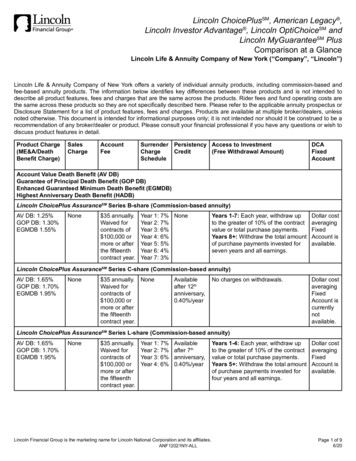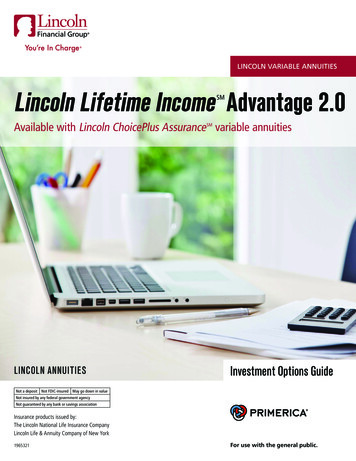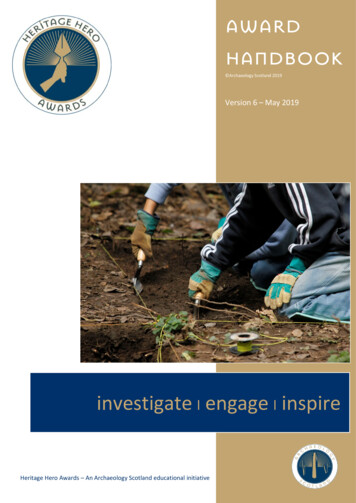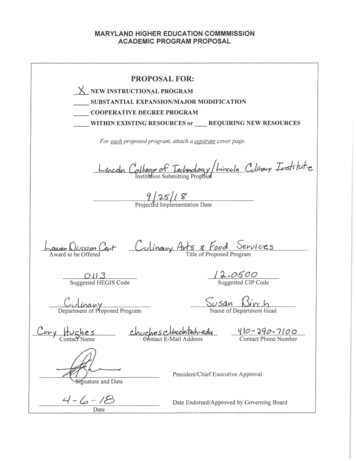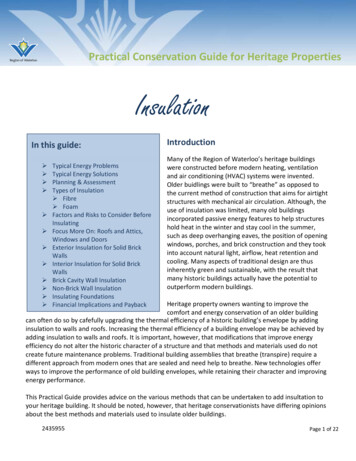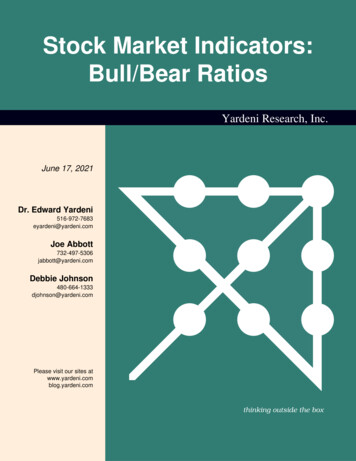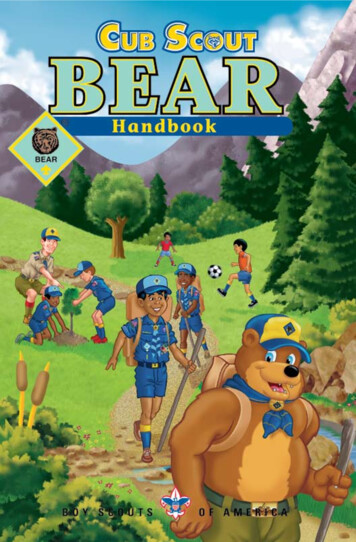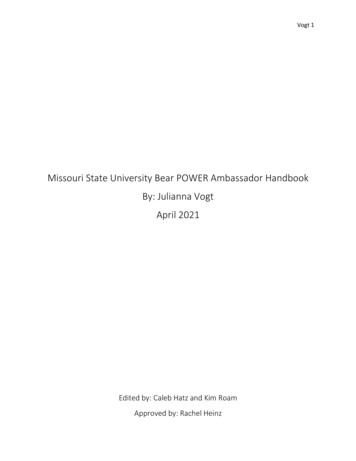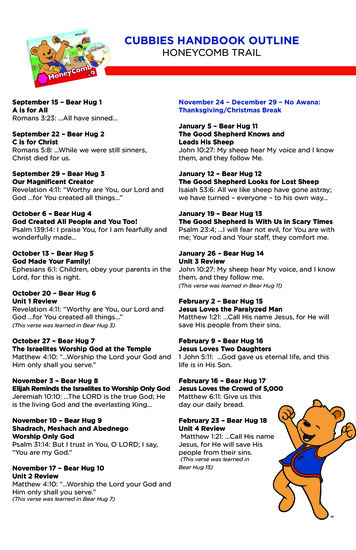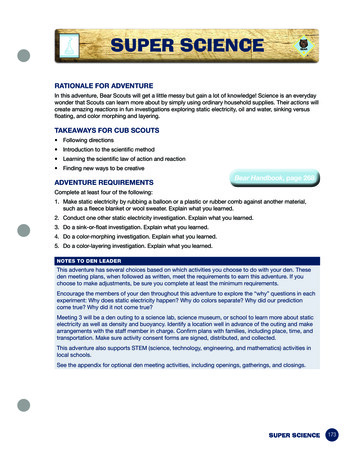
Transcription
SUPER SCIENCERATIONALE FOR ADVENTUREIn this adventure, Bear Scouts will get a little messy but gain a lot of knowledge! Science is an everydaywonder that Scouts can learn more about by simply using ordinary household supplies. Their actions willcreate amazing reactions in fun investigations exploring static electricity, oil and water, sinking versusfloating, and color morphing and layering.TAKEAWAYS FOR CUB SCOUTS Following directions Introduction to the scientific method Learning the scientific law of action and reaction Finding new ways to be creativeADVENTURE REQUIREMENTSBear Handbook, page 268Complete at least four of the following:1. Make static electricity by rubbing a balloon or a plastic or rubber comb against another material,such as a fleece blanket or wool sweater. Explain what you learned.2. Conduct one other static electricity investigation. Explain what you learned.3. Do a sink-or-float investigation. Explain what you learned.4. Do a color-morphing investigation. Explain what you learned.5. Do a color-layering investigation. Explain what you learned.NOTES TO DEN LEADERThis adventure has several choices based on which activities you choose to do with your den. Theseden meeting plans, when followed as written, meet the requirements to earn this adventure. If youchoose to make adjustments, be sure you complete at least the minimum requirements.Encourage the members of your den throughout this adventure to explore the “why” questions in eachexperiment: Why does static electricity happen? Why do colors separate? Why did our predictioncome true? Why did it not come true?Meeting 3 will be a den outing to a science lab, science museum, or school to learn more about staticelectricity as well as density and buoyancy. Identify a location well in advance of the outing and makearrangements with the staff member in charge. Confirm plans with families, including place, time, andtransportation. Make sure activity consent forms are signed, distributed, and collected.This adventure also supports STEM (science, technology, engineering, and mathematics) activities inlocal schools.See the appendix for optional den meeting activities, including openings, gatherings, and closings.SUPER SCIENCE173
MEETING1 PlANPREPARATION AND MATERIALS NEEDED U.S. and den flags “Lab coats” (Use old shirts throughout thisadventure, due to the risk of staining.) Items for Static Cling and Follow the Balloonactivities (requirement 1)— Balloon (If there are latex allergies in theden, substitute with a rubber or plasticcomb and a piece of PVC pipe.)— Polar fleece blanket or 1 wool sweater— Section of cloth— Tissue paper— Ribbon— Aluminum foil— Two aluminum cans, one empty and one full— Paper scraps— Cardboard scraps— Yarn or string— chenille stem— Coin— Pingpong ball— Running water Items for Flying Bottle Beads activity(requirement 2)— Empty, dry 1-liter bottle— 1 4 cup of small Styrofoam beads(like the ones in beanbag chairs) One pair of goggles for each member of theden (These are optional but they add to thefun, and experiments in this adventure can getmessy. However, if there are latex allergies, besure to use nonlatex goggles.)GATHERING: CARPET SHUFFLE SHOCKAs Scouts enter, let them shuffle their shoes along a carpet or rug to pick up extra electrons and anegative static charge. Then they touch a door knob, and zap! The electrons jump from the Scoutsto the knob (a conductor), and they feel a static shock.OPENING Conduct a flag ceremony of your choosing that includes the Pledge of Allegiance and the Scout Oathand Scout Law. Have each Scout answer the roll call with a noise they associate with science experiments(“Sploosh,” “Fizz,” “Glug,” etc.).TALK TIME174 Carry out business items for the den. Allow time for sharing among Cub Scouts. Ask: Have you ever heard the expression, “There is electricity in the air?” Well, in our Super Scienceadventure, we’re going to prove there is electricity in the air—static electricity. We’ll use our superscientist skills to show that static electricity, though invisible, can shock us, move paper, make our hairstand on end, and cause objects to fly!BEAR
ACTIVITIESNOTE: Use the second option for Activities 1 and 2 if anyone in the den has a latex allergy.Activity 1: Static Cling and Follow the Balloon (Requirement 1)Option 1: Create static electricity by rubbing the balloon on the fleece blanket or wool sweater. AskScouts to predict which of these objects will stick to the balloon: human hair, tissue paper, aluminum foil,cardboard scrap, paper scrap, yarn/string, chenille stem, ribbon, cloth, and a coin. Discuss your findingswith the den. Some objects will be more affected by static electricity than others.Then charge the balloon again with static by rubbing it on the blanket or sweater. Predict which of theseobjects will follow the balloon and which ones will move away from it: pingpong ball, full aluminum can,empty aluminum can, gentle stream of tap water. Discuss the results with your den. This is another waywe can prove that static electricity affects objects.Now rub the balloon on someone’s head. Watch what happensto their hair as negative electrons build up on the balloon. Afterdoing this for a few seconds, place the balloon near a steady,gentle stream of tap water, about 1/8-inch thick. Does the watermove toward or away from the balloon?Option 2: Vigorously rub the PVC pipe or rubber comb againstthe blanket or sweater. Then conduct the same investigationsas in Option 1 to see which objects stick to the pipe or comb.Conduct the same object and water investigations, substituting the comb for the balloon. For the water experiment, chargethe comb by vigorously rubbing it against the blanket orsweater or running it several times through long, dry hair. Thenplace the comb near the stream from the tap and see how thewater bends. In both options, the neutral water should beattracted to the electron-charged comb or balloon and movetoward it.Activity 2: Flying Bottle Beads (Requirement 2)Make sure the 1-liter bottle is empty and dry, then fill itwith the 1 4 cup of Styrofoam beads. Now rub the bottle onsomeone’s head and watch the beads fly around inside.Next, see what happens when you put the bottle down and touch it with your hands. Do the beads movetoward or away from your hands? Run the same investigations with more objects to check the reactionof the beads.CLOSINGAkela’s Minute: As electrons move around, they go from atom to atom and from object to object.Normally, we don’t even notice it. But when there are a lot of objects, they build up something called anegative charge. Picture a room getting really, really crowded. Everyone is moving around, gettingsquished, and they start to feel grumpy. Then the door opens, and people want to rush out to get awayfrom the crowd!Take that example and think about electrons: They build up their negative charge and have nowhere togo—until they meet another object. If they come near an object with fewer electrons (called a “lessercharge”), all of the extra electrons will rush over to the other object. Then you can hear a popping noiseand sometimes see a spark, just like our Carpet Shuffle Shock. When you get a shock from staticelectricity, it’s because a negative charge left an object and jumped to your body.What a super reaction from electrons! Let us give a Bear cheer (or den yell) for the electrons. Good night,Super Scientist Bears!SUPER SCIENCE175
AFTER THE MEETING Serve refreshments, if desired. Record completion of requirements 1 and 2. Work together to clean up the meeting place. Take a group photo of the den to be printed out and used during the opening of Meeting 2. Prepare thank-you notes for the Bears to sign at the next meeting. The notes should be given toanyone who helps with the outing.MEETING2 PlANPREPARATION AND MATERIALS NEEDED U.S. and den flags Photo of the den for the opening “Lab coats” (see Meeting 1) Items for Sticks and Spoons game (Gathering)— 10 marbles per Scout— Plastic straws (same size, 1 per Scout)— Spoons (same size, 1 per Scout)— Plastic cups (same size, 1 per Scout) Items for Bear Science Experiment (Opening)— One large pot— Index cards (1 per Scout)— One copy of den group photo from Meeting 1 Items for Sink or Float investigation(Requirement 3)— Three eggs— Three drinking glasses (same size)— Salt (2 tablespoons, more or less,depending on size of glasses)— Sugar (same as above)— Water— Tablespoon Items for Color Morphing investigation(Requirement 4)— One large jar or vase (must be clear)— Water— Cooking oil— Liquid food coloring (blue, red, and yellow)— Tablepoon— Measuring cup Items for Color Layering investigation— Sugar (15 tablespoons)— Water (15 tablespoons)— Food coloring (blue, green, red, and yellow)— Six clear plastic cups (same size)— TablespoonGATHERING: STICKS AND SPOONSAs they enter, give all Scouts a straw, a plastic cup, and a spoon and have them sit on the floor with 10marbles scattered near each of them. At the word “Go,” give them 50 seconds to pick up as many marblesas possible—using only the straw and spoon—and drop them into their cups. Each Scout keeps their ownscore (“a Scout is trustworthy”). After everyone has arrived and played the game, declare the winner.OPENING176 Conduct a flag ceremony of your choosing that includes the Pledge of Allegiance and the Scout Oathand Scout Law. Bear Science Experiment: Give each Scout an index card with one or points of the Scout Lawwritten on it. In turn, have each Scout name the point they are holding and drop it into the pot. Thenreach into the pot and pull out last week’s picture of the den. Explain that all of us together, byfollowing the Scout Law, create a den that does great things!BEAR
TALK TIME Carry out business items for the den. Allow time for sharing among Cub Scouts. Ask if they have seen any static electricity in their homes or at school since the last meeting. Havethem share any stories. Review plans for Meeting 3, an outing to a science lab, science museum, or school. Tell the Scouts: At this meeting, we will discover how we can make eggs sink or float, suspend colorsin water, and make a rainbow in a cup of water!ACTIVITIESActivity 1: Sink or Float (Requirement 3)Ask Bears: Can you guess—or use your Super Science to “hypothesize”—whether an egg will sink orfloat in water that is salty? What if the water is filled with sugar? And what if the water has nothingadded? Well, we can use our Super Science to find out.Now conduct the investigation. Fill all three glasses with water. Have the Scouts leave plain water in the firstglass, stir salt into the second one, and stir the same amount of sugar into the third glass. Can the Scoutspredict what will happen when they add an egg to each glass? Let them try it and see if the eggs sink or float.Then continue: In this adventure, we experimented with what scientists call “variables.” We left plainwater in the first glass, but we stirred salt into the second glass and sugar into the third one. Salt makeswater denser so the egg floats at the top. Using the same amount of sugar, the egg still floats, but not aswell. In plain water, it doesn’t float at all. Did your findings support your hypothesis or should you havemade a different prediction?SUPER SCIENCE177
Activity 2: Color Morphing (Requirement 4)Ask: Have you ever heard the saying “Oil and water don’t mix”?Let’s use our Super Science to find out if that is true. Then we’llexperiment more by adding colors to the liquid. What do youpredict will happen?Have the Scouts fill the jar or vase with water. Then addexactly 3 drops each of red, blue, and yellow food coloringto the oil (no more or it will turn black). Stir the color and oiltogether—you will see it break up into little droplets. Slowlypour the mix into the water and watch the show begin!Now ask: What is happening? Did you guess right? Oil andwater do not mix. When stirred together in the same container,they will actually push away from each other once the motionstops. When you added the food coloring to the oil, you stirredit, mixing the two together. Once this is added to the water andallowed to be still, the water and oil start to separate. Liquidfood coloring is water-based. This causes the colors to pushaway from the oil. As the colors move through the water, itcauses a beautiful color morphing effect. If you have moretime for this activity, try it with different color combinations.Activity 2: Color Layering (Requirement 5)Set out the materials for this investigation, and say: We foundout how to create unique designs with colors in liquid. Now,can we put those colors together in layers to create a rainboweffect? Let’s use Super Science to see.Place five of the cups in a row. Keeping the cups in order, add1 tablespoon of sugar to the first cup, 2 tablespoons to thesecond, 3 tablespoons to the third, 4 tablespoons to thefourth, and 5 tablespoons to the fifth cup. Keep the sixthcup empty.Pour 3 tablespoons of lukewarm water on top of the sugar inthe first five cups, and stir until the mix dissolves. Now add adifferent food color to the first four cups and combine two ofthe colors in the fifth cup. Stir the five cups again.Now, pour half the contents of the fifth cup into the sixth cup.Take the spoon and place it against the inside of the cup, bowlside up. (Note: Using a spoon diffuses the force of the liquidpouring into the cup. This will let the colors layer on top of oneanother instead of mixing.) Be sure to pour gently, creating thefirst layer, and continue doing this with the remaining threecups. Enjoy the rainbow in your sixth cup!Explain: Adding sugar to the water causes it to become thickeras the sugar molecules take over the space. The more sugaryou add, the denser the water becomes. This lets you stack thecolored water as long as you pour it gently.178BEAR
CLOSING Den Electricity: Have Bears stand in a circle facing inside. Ask each Scout to turn all the way to theirright and place both hands on the shoulders of the person in front of them. Everyone starts walkingslowly, shuffling their feet. Tell the den: When we work together, we create electricity. Not only thestatic electricity that gives a little spark when we shuffle on carpet, but the giant spark when we learnand grow together as Scouts. Pass out activity consent forms for Scouts to have signed by a parent or guardian before Meeting 3,the den outing. Confirm the location and transportation plans.AFTER THE MEETING Serve refreshments, if desired. Record completion of requirements 3, 4, and 5. Work together to clean up the meeting place. Have the Scouts sign thank-you notes for anyone helping with the outing.MEETING3 PlAN (Den outing)PREPARATION AND MATERIALS NEEDED Be sure all arrangements are made for the den to visit a science lab, science museum, or school tolearn more about static electricity, and density and buoyancy. Contact the location well in advanceand confirm all plans with the staff member in charge. Check to see if the physics department at alocal college or university might be willing to assist in the tour. Confirm that transportation to and from the site is in place. Secure signed activity consent forms. STEM activities (science, technology, engineering, and mathematics) may also be included in this outing.GATHERING Remind Scouts to be courteous during the outing. Remind everyone of the importance of staying together and being on their best behavior. Use the buddy system. Review any questions the Scouts want to ask to make certain all are appropriate.OPENING Assemble the group, and review any conduct rules and the buddy system. Say the Pledge of Allegiance. Ask Scouts to name points of the Scout Law they will demonstrate during the outing (friendly,courteous, etc.).TALK TIME Carry out business items for the den.SUPER SCIENCE179
ACTIVITYActivity 1: Outing (Optional) Ask the professional guiding the tour to share about the different jobs available in the field of physics.Perhaps the guide can tell the Scouts about educational requirements for those jobs and whatclasses in school might help prepare them. Ask the guide if he or she knows of a science club for young people in the area.CLOSING Plan a cheer in advance to give to helpers at the facility, including the tour guide.AFTER THE MEETING Serve refreshments, if desired. Ensure cleanup takes place, if needed.Upon completion of the Super Science adventure, your Bears will have earned the adventureloop shown here. Make sure they are recognized for their completion by presenting theadventure loops, to be worn on their belts, as soon as possible according to yourpack’s tradition.180BEAR
A WoRlD of SoUNDRATIONALE FOR ADVENTUREEvery culture has its own unique instruments. In this adventure, Scouts will “visit” three different partsof the world and explore some of their musical sounds. Scouts will get the chance to make their ownversions of three instruments from those places and take them home to share with their family.TAKEAWAYS FOR CUB SCOUTS A basic understanding of world musical culture Cooperation and sharing while making instruments Creativity Deductive reasoning when it comes to sound Respect for other countriesADVENTURE REQUIREMENTSBear Handbook, page 280Complete all of the following:1. Make an mbira.2. Make a sistrum.3. Make a rain stick.NOTES TO DEN LEADERIn this adventure, you and your den will be able to experience something every culture has in common—music! Your Bear den will be able to explore three different instruments made from easily found andrecycled materials. It might be good to download audio samples online in advance of each meeting soScouts can hear what each instrument sounds like. A great time to share your instruments would be at apack meeting.MEETING1 PlANPREPARATION AND MATERIALS NEEDED U.S. and den flags Map of Africa Materials for constructing an mbira (see this adventure in the Bear Handbook) If you wish, try to find someone who has knowledge or experience with this instrument who couldvisit the den meeting and speak with the Scouts. Check with local cultural centers, museums, or themusic department at a nearby college.A WoRlD of SoUND181
GATHERINGPlay a game of Ampe, Ampe (AM-pay). Schoolchildren play this game in Ghana, Africa. It is very similarto Rock Paper Scissors.Instructions:Pick one player as the leader. That player stands on one side and the others stand in a line facing theleader. The leader then walks across and stands opposite the first player in line, and they both do thefollowing actions at the same time:1. Say, “Ampe, Ampe.”2. Clap your hands.3. Jump in place and land with one foot forward.If both of them put the same foot forward, the leader sits down and the other Scout take the leader’s place.If each puts a different foot forward, the leader moves to the next player in line and they repeat the actions.OPENING Conduct a flag ceremony of your choosing that includes the Pledge of Allegiance and the Scout Oathand Scout Law. Have Bears answer the den roll call with the Swahili word for Yes, ndiyo z (en-DEE-yo), or Hello,jambo (JAM-bo).TALK TIME Carry out business items for the den. Allow time for sharing among Cub Scouts. Tell the Scouts it is time to visit Africa and learn about one of the musical instruments, played there,the mbira—a wooden board with metal or wooden strips, or tines, that vibrate when you pluck them. Display a map of Africa so the Scouts can get a sense of where the instrument comes from. Thembira has been an important instrument in Africa for more than 800 years, and it is known by thatname throughout much of the continent. But depending on the country you visit, the style of theinstrument may be different and called by a different name:— mbira in Zimbabwe— kalimba (kuh-LIM-buh) in Kenya— ikembe (ee-KEM-bay) in Rwanda— likembe (lee-KEM-bay) in the Democratic Republic of the CongoThese versions of the mbira are different in appearance, just as there are various types and styles ofsome instruments in the United States, like the guitar. Some mbiras have only six tines to pluck, whileothers have as many as 33. The instrument can be played by itself, but normally several mbiras areplayed together to accompany singers or dancers.In our country, this kind of instrument might be called a finger harp, a gourd piano, or a thumb piano—because you use your thumbs to pluck (depress and release) the metal strips (tongues or lamellas) thatmake particular musical notes.ACTIVITIESActivity: Make an Mbira (Requirement 1)See instructions in the Bear Handbook for making an mbira. After each Scout has made one, take sometime to experiment. Have the Scouts see what difference it makes if a player uses a craft stick insteadof their thumb to pluck the tines. Ask: What happens when a metal spoon? How about a plastic spoon?Does the noise change depending on whether wood, metal, or plastic? Have them try to play a simpletune like “Happy Birthday” or “Twinkle Twinkle Little Star.”182BEAR
CLOSINGAkela’s Minute: Tell the Scouts that while people around the world may be different in many ways,they are the same in many other ways. This adventure helps us to understand that other cultures havemusical instruments and enjoy music just as we do. Likewise, when friends in other cultures close ameeting or gathering, they wish for their friends to remain safe until they see each other again. Have theScouts turn to each other and say kuwa salama (KOO-uh sa-LA-ma), which means “Be safe” in Swahili,a language used widely in East Africa and the Congo region.AFTER THE MEETING Serve refreshments, if desired. Record completion of requirement 1. Work together to clean up the meeting place.MEETING2 PlANPREPARATION AND MATERIALS NEEDED U.S. and den flags Map of Egypt Materials for constructing a sistrum (see this adventure in the Bear Handbook) If you wish, try to find someone who has knowledge or experience with this instrument who couldvisit the den meeting and speak with the Scouts. Check with local cultural centers, museums, or themusic department at a nearby college.GATHERINGPlay thumb wrestling, an ancient Egyptian game.Instructions:Divide the Scouts into pairs as they arrive for the den meeting. Have each Scout link four fingers on onehand with the same four fingers on the other’s hand. Both of them should leave their thumbs free, facingup. On the count of three, they “wrestle” with their thumbs. The winner is the first player who can holdthe other’s thumb down for more than 3 seconds.NOTE: Adults should not thumb wrestle with the Scouts. Remind everyone that good sportsmanship isimportant, and they are not to hold each other’s thumbs down for more than 3 seconds.A WoRlD of SoUND183
OPENING Conduct a flag ceremony of your choosing that includes the Pledge of Allegiance and the Scout Oathand Scout Law. Refer to Ceremonies for Dens and Packs for additional guidance. Have Bears answer the den roll call with the Arabic word for Yes, Aiwa (you-wa), or Hello,Ahlain (Ah-len). Share this information with them about the gathering activity they just did: The ancient Egyptiansplayed many of the same games that we do today. If you look at pictures of Egyptian artwork, you willsee people throwing javelins, wrestling, swimming, running, etc. The game you just played (thumbwrestling) is one that ancient Egyptians also played.TALK TIME Carry out business items for the den. Allow time for sharing among Cub Scouts. Display the map of Egypt and tell Bears that, for this meeting, they will travel 3,000 years back in timeto ancient Egypt where they will learn how to make a sistrum. This instrument is a type of Egyptianmusical rattle that was used to play songs for the pharaohs of Egypt. There are many wall paintings ofmusicians playing their sistrums for the Egyptian royalty. In those days, sistrums were made out ofbone, wood, and strong plant fibers. To make our sistrums, we will use materials found around us thatgive us the same look and sound as those early instruments (see this adventure in the Bear Handbook).ACTIVITIESActivity: Make a Sistrum (Requirement 2) Have Scouts make their sistrums (see instructions in this adventure in the Bear Handbook). After this is done, play a song and have them try to match the rhythm of the song with the rattle of theirsistrums. Then ask: Was it easier to match the beat by shaking the sistrum or by sliding it back andforth? Now use your Bear ears: What sound in nature is similar to the sound of a sistrum? Does thesistrum sound like wind blowing through tall grass? Like an animal? Like the gentle noise of a river?CLOSING Akela’s Minute: This week we traveled again—not only to another country, but also back in time.Egyptian history gives us details of one of the earliest cultures that has been discovered, and morediscoveries are being made even now. Since we have been on a journey this week both in time andplace, let’s wish each other a safe journey in Arabic until we come together for the next meeting.Bissalama. That means “Have a safe journey!”AFTER THE MEETING184 Serve refreshments, if desired. Record completion of requirement 2. Work together to clean up the meeting place.BEAR
MEETING3 PlANPREPARATION AND MATERIALS NEEDED U.S. and den flags Map of Chile (or a map of South America) 1 spinning top for each Scout in the gathering activity Materials for making a rain stick (see this adventure in the Bear Handbook) If you wish, try to find someone who has knowledge or experience with this instrument who couldvisit the den meeting and speak with the Scouts. Check with local cultural centers, museums, or themusic department at a nearby college.GATHERINGHave the den play a game of Trompo, or “Whipping Top.” Trompo has been played by people in LatinAmerica since approximately 2,800 BC. It is a version of spinning tops.Instructions:Tape a circle on the floor or ground for playing tops, and give one to each Scout as they arrive. Pair upthe Scouts and have them spin their tops to see which one will be knocked out of the circle.OPENING Conduct a flag ceremony of your choosing that includes the Pledge of Allegiance and the Scout Oathand Scout Law. Have the Scouts answer the den roll call with the Spanish word for Yes, Sí, or Hello, Hola. Spanish isthe official language spoken in Chile.TALK TIME Carry out business items for the den. Allow time for sharing among Cub Scouts. Display the map of Chile or the map of South America, pointing out where Chile is. Remind Bears thatthey traveled to Africa and Egypt in the first two meetings of this adventure, and now it’s time to go tothe country of Chile. Explain that rain sticks—which are thought to produce rain by artificial means—are found in manycultures where plants must be kept growing for communities to survive. The Diaguita Indians of Chilehave been making rain sticks for centuries. They dance and shake them to imitate the sound of rain. The original rain sticks were made out of cacti. A piece of cholla cactus would be cut off and left todry out. The spikes on the outside were then scraped away so it would be safe to hold the rain stick.The spikes on the inside were left intact so that when the “stick” was filled with seeds, beans, orsmall rocks, a unique noise would be made as they fell softly past each spike.A WoRlD of SoUND185
ACTIVITIESActivity: Make a Rain Stick (Requirement 3)Tell the Scouts: Since we don’t have cacti growing at our meeting place, we will use cardboard tubes andother modern items to recreate the sound of rain. (See this adventure in the Bear Handbook for a list ofmaterials and instructions.) There are many ways to control the sound of a rain stick: The length of thestick makes a difference and so do the items that you choose to put inside. Decide on the combination ofsounds and size before you create your rain stick. Everyone’s rain stick will be a little bit different.After the rain sticks are completed, discuss the sounds the sticks made. Say: Use your Bear ears. Whatsound from nature did your rain stick make? Did it sound like the rain on your roof? Did it make the soundof a waterfall? When you shook it, did it sound like thunder?CLOSINGHave the Scouts stand at attention and repeat the Scout Oath. Then have them turn to each other andsay, “Cuídate” (KWEE-da-tay), which is Spanish for “Be safe.”AFTER THE MEETING Serve refreshments, if desired. Record completion of requirement 3. Work together to clean up the meeting place.Upon completion of the A World of Sound adventure, your Bears will have earned theadventure loop shown here. Make sure they are recognized for their completion by presentingthe adventure loops, to be worn on their belts, as soon as possible according to yourpack’s tradition.186BEAR
AppendixThe appendix gathers information that you may find helpful for leading any of the adventures.Appendix 1: parts of Your MeetingGathering Activities .A-7Baden-Powell Says. A-7Concentration . A-7Craft Stick Puzzles . A-7Hot or Cold . A-7Marble Golf . A-7Milk Jug Toss . A-7Odd or Even . A-8Pong.
Bear Handbook , page 268. 174 BEAR MEETING 1 PlAN PREPARATION AND MATERIALS NEEDED U.S. and den !ags “Lab coats” (Use old shirts throughout this adventure, due to the risk of staining.) Items for Stati
